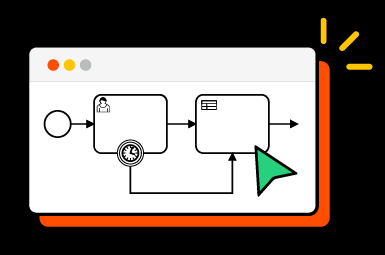Since we launched Camunda Platform 8 a few weeks back, we’ve been learning from the experience of early adopters like Swiss Re and had the opportunity to hear from users and experts at Camunda Community Summit. If you’ve heard anything about Camunda Platform 8, then you probably know that its breakthrough in speed, scale, and resiliency for process automation is made possible by Zeebe, our cloud-native workflow engine. But you might be wondering about the specifics — what’s really so cool about Zeebe and Camunda Platform 8?
Camunda Platform 8’s Zeebe delivers better support for IT and business collaboration, more flexible and efficient process execution, and instant transparency with troubleshooting issues. Let’s spotlight 10 of Camunda Platform 8’s new features that merit a closer look.
Unlimited horizontal scalability for process execution
Designed for resilience and high availability
Choose your own programming language
Real-time collaboration on business process models
Quickly build and deploy forms for user tasks
Open standards that facilitate collaboration
Out-of-the-box connectors unlock universal orchestration
Powerful tools for troubleshooting and resolving incidents
Intuitive visualization of process performance and bottlenecks
Performance monitoring and alerting for important KPIs
Unlimited horizontal scalability for process execution
Traditional BPMN-based workflow engines may not be fit to support some high-throughput use cases, but Camunda Platform 8 brings the advantages of BPMN to any relevant use case. Zeebe can be scaled by adding cluster nodes that support the processing of an unlimited number of transactions at consistent low latencies. Zeebe doesn’t depend on an external database, so there’s no database bottleneck, and it’s easy to distribute processing across a cluster of machines to deliver high throughput.
Designed for resilience and high availability
Zeebe is a truly distributed workflow engine that leverages modern fault-tolerance techniques like the raft consensus algorithm for scalability and resilience. There’s no single point of failure with Zeebe because it operates as a cluster of brokers that all have the same responsibilities. Zeebe’s distributed nature means it can support geo-replication across data centers, ensuring high availability and providing failover protection.
Choose your own programming language
Zeebe’s architecture is based on the idea of clients that send commands to Zeebe to deploy processes, carry out business logic, and handle operational issues (such as resolving incidents). Job workers are clients that use the Zeebe API to activate jobs and then complete or fail them. You can use any gRPC-supported programming language to implement job workers, or you can use out-of-the-box clients written in Java, Node.js, and other popular languages. This flexibility makes Camunda Platform 8 a great choice for organizations that use a variety of programming languages, and makes it easier for teams to add Camunda-based code to their automated testing and CI/CD pipelines.
Real-time collaboration on business process models
Our process design tool Camunda Modeler supports real-time collaboration between the business users who are intimately familiar with the business processes and the IT teams who develop the automation. The collaboration features include support for commenting, presenting, sharing, embedding, versioning, and deploying BPMN process models and DMN decision tables. This collaboration drastically reduces the time it takes to design, implement, deploy, and change business processes.
Quickly build and deploy forms for user tasks
Business processes that involve human work typically require you to create forms that accept input from end users. Our Form Builder allows developers to build task forms by using a drag-and-drop interface instead of writing code. They can then implement their form by referring to it in a BPMN User Task or Start Event. The Form Builder makes it much faster and easier to build a task form that “just works,” with no coding required. Even a developer who has experience writing HTML will find this feature useful because it allows them to quickly create a working task form so they can move on to more complex development work.
Open standards that facilitate collaboration
Business Process Model and Notation (BPMN) is the global standard for process modeling because it balances simplicity and ease-of-use with the power of expression for complex business processes. Similarly, Decision Model and Notation (DMN) allows you to model the rules that lead to a business decision in easy-to-read, executable tables. At Camunda, we’re committed to using these open modeling standards because they facilitate collaboration between teams and ensure that process logic isn’t buried in code that business users can’t read. Open standards also help companies avoid the vendor lock-in that proprietary tools can bring. We offer training courses that help teams get started with both BPMN and DMN.
Out-of-the-box connectors unlock universal orchestration
Connectors are reusable building blocks that communicate with any system or technology, reducing the time it takes to automate and orchestrate business processes across a variety of process endpoints. Outbound connectors allow a process to invoke an outside system to do something, and inbound connectors allow a process to be triggered by an outside system. You can insert connectors into BPMN diagrams directly from the Modeler interface and configure them using an intuitive properties panel.
Powerful tools for troubleshooting and resolving incidents
Incidents are inevitable. You need powerful tools that notify you when an incident occurs, help you analyze the situation and pinpoint the root cause, and give you the power to apply a fix, so customers aren’t stuck. Operate is our toolkit for discovering, analyzing, and resolving incidents. With Operate, you can easily edit process variables, schedule service task retries, cancel process instances, or deploy a new version of a process diagram. Operate allows you to safely execute batch operations on hundreds or thousands of process instances with a few clicks.
Intuitive visualization of process performance and bottlenecks
Camunda Optimize supports end-to-end visualization of business processes with performance metrics for each process step. Optimize adapts to your needs by allowing you to set target values on process steps, so you know how long they should normally take. You’ll get an intuitive visualization of performance bottlenecks in the form of a BPMN heatmap that makes it easy to see which steps are taking longer than they should—so you know where to focus your improvement efforts.
Performance monitoring and alerting for important KPIs
Optimize reports on both real-time and historical data, so it can monitor the performance of processes and notify you when the KPIs you care about reach a predefined critical value. Notifications help process owners identify performance problems as quickly as they come up, instead of waiting to hear about issues from other stakeholders or worse, from customers. Optimize can send notifications via email or send them to an external alerting system.
But don’t take our word for it…
You can try Camunda Platform 8 yourself. Sign up for a free 30-day trial and get started with tutorials for microservices orchestration and human task orchestration.


